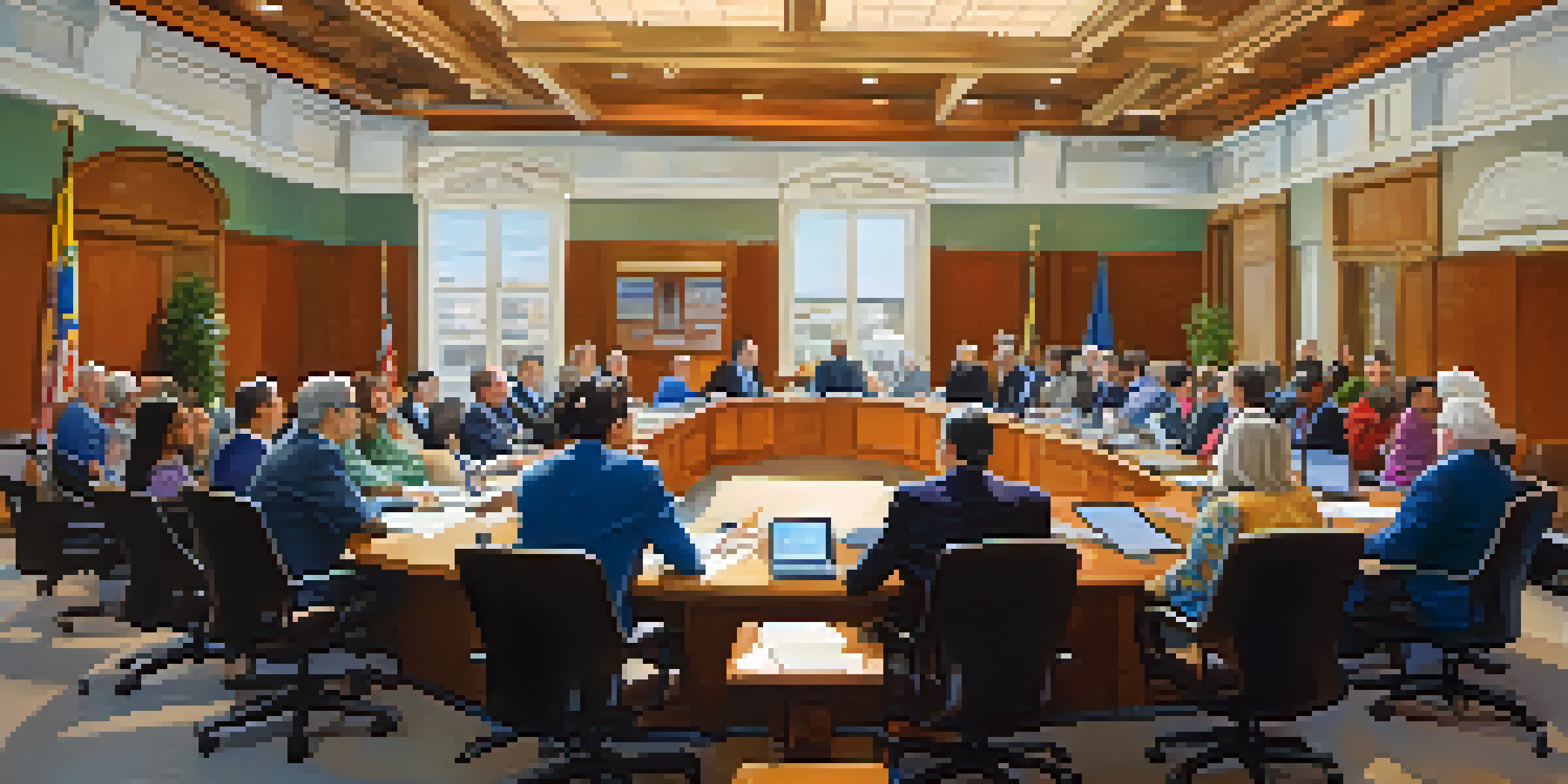Understanding Sacramento's City Council: Structure and Roles

An Overview of Sacramento's City Council Structure
Sacramento's City Council is the legislative body responsible for making decisions that affect the city. Comprised of a mayor and eight council members, this council plays a crucial role in local governance. Each member represents a specific district, ensuring that diverse community voices are heard and considered in city matters.
The greatest gift of the city is not its buildings or its streets, but its people and their voices.
The mayor, elected citywide, serves not only as a council member but also as the figurehead for the city. This dual role allows the mayor to influence policy while also representing the interests of all citizens. Together, the council and mayor work collaboratively to develop and pass city ordinances, budgets, and policies.
This unique structure emphasizes local representation and accountability. By having council members elected from specific districts, residents can engage directly with their representatives, fostering a sense of community involvement in local government.
The Roles of the Mayor in City Council Decisions
The mayor of Sacramento possesses significant influence within the City Council. As the primary leader, the mayor not only votes on issues but also sets the agenda for meetings, guiding discussions on key topics. This role is essential for prioritizing community needs and shaping the city's strategic direction.

In addition to legislative duties, the mayor also acts as the city's spokesperson, representing Sacramento in public events and regional discussions. This visibility helps to advocate for the city's interests and secure funding or support for local initiatives. It’s a balancing act between governance and public relations.
Sacramento's City Council Structure
The City Council, consisting of a mayor and eight district representatives, ensures local governance and community engagement.
Moreover, the mayor collaborates with the council members to ensure that the needs of different districts are addressed. By fostering a cooperative environment, the mayor encourages productive dialogue among council members, which ultimately benefits the entire city.
Understanding the District Representation of Council Members
Each council member in Sacramento represents one of the city's districts, allowing for localized governance. This system ensures that specific community concerns are brought directly to the council's attention. For residents, this means they have a dedicated representative who focuses on their unique needs and challenges.
Democracy is not a spectator sport; it requires active participation from all citizens.
District representation fosters accountability, as council members must engage with their constituents regularly. This relationship encourages transparency and responsiveness, making it easier for residents to voice their opinions and influence local policies. It’s about building trust between elected officials and the community.
Moreover, council members often collaborate with local organizations and neighborhood groups to better understand the issues facing their districts. This grassroots approach to governance ensures that decisions are informed by those who are most affected by them, leading to more effective and relevant policies.
The Legislative Process in Sacramento's City Council
The legislative process in Sacramento begins with the introduction of a proposal, which can come from the mayor, a council member, or even community members. Once introduced, the proposal is reviewed by the council, and public input is solicited. This inclusive process helps to ensure that various perspectives are considered before any decision is made.
Next, the proposal often goes through committee meetings where detailed discussions take place. These meetings are vital for examining the implications of the proposed legislation and making necessary adjustments. It’s a thorough vetting process that allows for a deeper understanding of how the proposal will impact the community.
Mayor's Influence in Governance
The mayor plays a pivotal role in setting the council's agenda and advocating for the city's interests while collaborating with council members.
Finally, the proposal is brought to the full City Council for a vote. If approved, it becomes law, contributing to the ongoing development and improvement of Sacramento. This structured process underscores the importance of collaboration and community engagement in local governance.
Key Committees Supporting Sacramento's City Council
Sacramento's City Council operates through various committees, each focusing on specific areas like public safety, housing, and budget. These committees play an essential role in managing the city's affairs by allowing council members to specialize in areas of interest or expertise. This division of labor helps streamline discussions and decision-making.
Committee meetings often involve input from experts and community members, providing a platform for diverse voices to be heard. This collaborative approach ensures that decisions are based on comprehensive information and reflect the needs of the community. It’s a way to enrich the legislative process with real-world insights.
In addition, these committees help prepare proposals for the full council, making the overall legislative process more efficient. By breaking down complex issues into manageable discussions, council members can focus on crafting effective solutions that benefit Sacramento as a whole.
Public Participation in City Council Meetings
Public participation is a cornerstone of Sacramento's City Council meetings. Residents have the opportunity to voice their opinions, ask questions, and provide feedback on various issues. This engagement not only empowers citizens but also enriches the decision-making process with real community insights.
City Council meetings are typically open to the public, and there are formal opportunities for residents to speak during designated public comment periods. This transparency fosters a sense of ownership among residents, allowing them to feel more connected to the governance process. It’s a reminder that their voices matter.
Engaging the Community in Decisions
Public participation is fundamental in City Council meetings, allowing residents to voice their opinions and shape local policies.
Moreover, the council encourages various forms of feedback, including written comments and online submissions. This flexibility ensures that everyone, regardless of their schedule, can participate in shaping their city's future. Engaging the community in this way strengthens democracy at the local level.
The Role of City Staff in Supporting the Council
City staff play a vital role in supporting Sacramento's City Council by providing expertise and research on various issues. These professionals help prepare reports, conduct analyses, and offer recommendations that inform the council's decision-making. Their work ensures that council members have the necessary information to make informed choices.
Staff members often assist in drafting proposed legislation, ensuring that it aligns with legal requirements and community needs. This behind-the-scenes work is crucial for maintaining the integrity and effectiveness of local governance. It’s a collaboration that underscores the importance of teamwork in public service.

Additionally, city staff facilitate communication between the council and the community. They help organize public meetings, manage outreach efforts, and address citizen inquiries. This connection helps to bridge the gap between local government and residents, fostering a cooperative relationship that benefits everyone.